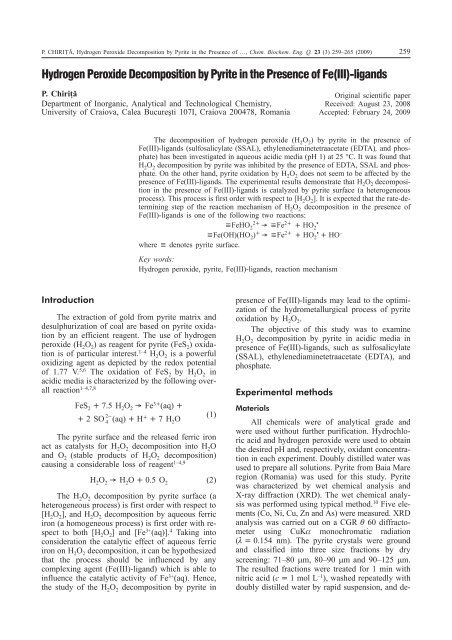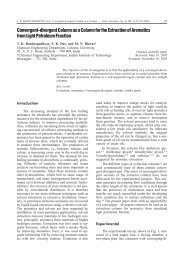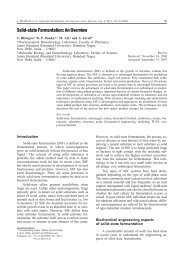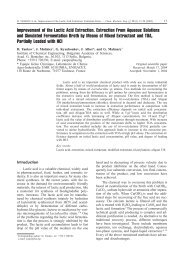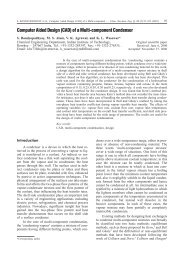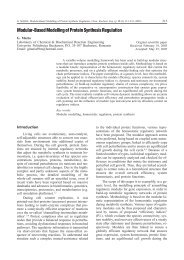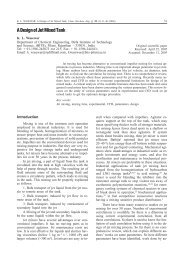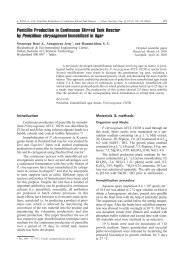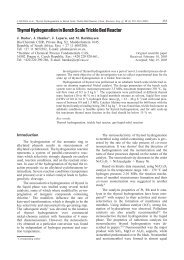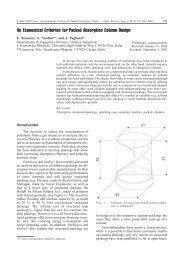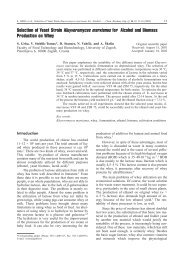Hydrogen Peroxide Decomposition by Pyrite in the Presence of Fe ...
Hydrogen Peroxide Decomposition by Pyrite in the Presence of Fe ...
Hydrogen Peroxide Decomposition by Pyrite in the Presence of Fe ...
You also want an ePaper? Increase the reach of your titles
YUMPU automatically turns print PDFs into web optimized ePapers that Google loves.
P. CHIRIȚÃ, <strong>Hydrogen</strong> <strong>Peroxide</strong> <strong>Decomposition</strong> <strong>by</strong> <strong>Pyrite</strong> <strong>in</strong> <strong>the</strong> <strong>Presence</strong> <strong>of</strong> …, Chem. Biochem. Eng. Q. 23 (3) 259–265 (2009) 259<strong>Hydrogen</strong> <strong>Peroxide</strong> <strong>Decomposition</strong> <strong>by</strong> <strong>Pyrite</strong> <strong>in</strong> <strong>the</strong> <strong>Presence</strong> <strong>of</strong> <strong>Fe</strong>(III)-ligandsP. ChirițãDepartment <strong>of</strong> Inorganic, Analytical and Technological Chemistry,University <strong>of</strong> Craiova, Calea Bucureºti 107I, Craiova 200478, RomaniaOrig<strong>in</strong>al scientific paperReceived: August 23, 2008Accepted: <strong>Fe</strong>bruary 24, 2009The decomposition <strong>of</strong> hydrogen peroxide (H 2 O 2 ) <strong>by</strong> pyrite <strong>in</strong> <strong>the</strong> presence <strong>of</strong><strong>Fe</strong>(III)-ligands (sulfosalicylate (SSAL), ethylenediam<strong>in</strong>etetraacetate (EDTA), and phosphate)has been <strong>in</strong>vestigated <strong>in</strong> aqueous acidic media (pH 1) at 25 °C. It was found thatH 2 O 2 decomposition <strong>by</strong> pyrite was <strong>in</strong>hibited <strong>by</strong> <strong>the</strong> presence <strong>of</strong> EDTA, SSAL and phosphate.On <strong>the</strong> o<strong>the</strong>r hand, pyrite oxidation <strong>by</strong> H 2 O 2 does not seem to be affected <strong>by</strong> <strong>the</strong>presence <strong>of</strong> <strong>Fe</strong>(III)-ligands. The experimental results demonstrate that H 2 O 2 decomposition<strong>in</strong> <strong>the</strong> presence <strong>of</strong> <strong>Fe</strong>(III)-ligands is catalyzed <strong>by</strong> pyrite surface (a heterogeneousprocess). This process is first order with respect to [H 2 O 2 ]. It is expected that <strong>the</strong> rate-determ<strong>in</strong><strong>in</strong>gstep <strong>of</strong> <strong>the</strong> reaction mechanism <strong>of</strong> H 2 O 2 decomposition <strong>in</strong> <strong>the</strong> presence <strong>of</strong><strong>Fe</strong>(III)-ligands is one <strong>of</strong> <strong>the</strong> follow<strong>in</strong>g two reactions:<strong>Fe</strong>HO 2 2 <strong>Fe</strong> 2 HO 2•<strong>Fe</strong>(OH)(HO 2 ) <strong>Fe</strong> 2 HO 2 • HO –where denotes pyrite surface.Key words:<strong>Hydrogen</strong> peroxide, pyrite, <strong>Fe</strong>(III)-ligands, reaction mechanismIntroductionThe extraction <strong>of</strong> gold from pyrite matrix anddesulphurization <strong>of</strong> coal are based on pyrite oxidation<strong>by</strong> an efficient reagent. The use <strong>of</strong> hydrogenperoxide (H 2 O 2 ) as reagent for pyrite (<strong>Fe</strong>S 2 ) oxidationis <strong>of</strong> particular <strong>in</strong>terest. 1–4 H 2 O 2 is a powerfuloxidiz<strong>in</strong>g agent as depicted <strong>by</strong> <strong>the</strong> redox potential<strong>of</strong> 1.77 V. 5,6 The oxidation <strong>of</strong> <strong>Fe</strong>S 2 <strong>by</strong> H 2 O 2 <strong>in</strong>acidic media is characterized <strong>by</strong> <strong>the</strong> follow<strong>in</strong>g overallreaction 1–4,7,8<strong>Fe</strong>S 2 7.5 H 2 O 2 <strong>Fe</strong> 3 (aq) 2SO 2 4(aq) H 7H 2 O(1)The pyrite surface and <strong>the</strong> released ferric ironact as catalysts for H 2 O 2 decomposition <strong>in</strong>to H 2 Oand O 2 (stable products <strong>of</strong> H 2 O 2 decomposition)caus<strong>in</strong>g a considerable loss <strong>of</strong> reagent 1–4,9H 2 O 2 H 2 O 0.5 O 2 (2)The H 2 O 2 decomposition <strong>by</strong> pyrite surface (aheterogeneous process) is first order with respect to[H 2 O 2 ], and H 2 O 2 decomposition <strong>by</strong> aqueous ferriciron (a homogeneous process) is first order with respectto both [H 2 O 2 ] and [<strong>Fe</strong> 3+ (aq)]. 4 Tak<strong>in</strong>g <strong>in</strong>toconsideration <strong>the</strong> catalytic effect <strong>of</strong> aqueous ferriciron on H 2 O 2 decomposition, it can be hypo<strong>the</strong>sizedthat <strong>the</strong> process should be <strong>in</strong>fluenced <strong>by</strong> anycomplex<strong>in</strong>g agent (<strong>Fe</strong>(III)-ligand) which is able to<strong>in</strong>fluence <strong>the</strong> catalytic activity <strong>of</strong> <strong>Fe</strong> 3+ (aq). Hence,<strong>the</strong> study <strong>of</strong> <strong>the</strong> H 2 O 2 decomposition <strong>by</strong> pyrite <strong>in</strong>presence <strong>of</strong> <strong>Fe</strong>(III)-ligands may lead to <strong>the</strong> optimization<strong>of</strong> <strong>the</strong> hydrometallurgical process <strong>of</strong> pyriteoxidation <strong>by</strong> H 2 O 2 .The objective <strong>of</strong> this study was to exam<strong>in</strong>eH 2 O 2 decomposition <strong>by</strong> pyrite <strong>in</strong> acidic media <strong>in</strong>presence <strong>of</strong> <strong>Fe</strong>(III)-ligands, such as sulfosalicylate(SSAL), ethylenediam<strong>in</strong>etetraacetate (EDTA), andphosphate.Experimental methodsMaterialsAll chemicals were <strong>of</strong> analytical grade andwere used without fur<strong>the</strong>r purification. Hydrochloricacid and hydrogen peroxide were used to obta<strong>in</strong><strong>the</strong> desired pH and, respectively, oxidant concentration<strong>in</strong> each experiment. Doubly distilled water wasused to prepare all solutions. <strong>Pyrite</strong> from Baia Mareregion (Romania) was used for this study. <strong>Pyrite</strong>was characterized <strong>by</strong> wet chemical analysis andX-ray diffraction (XRD). The wet chemical analysiswas performed us<strong>in</strong>g typical method. 10 Five elements(Co, Ni, Cu, Zn and As) were measured. XRDanalysis was carried out on a CGR 60 diffractometerus<strong>in</strong>g CuK monochromatic radiation(0.154 nm). The pyrite crystals were groundand classified <strong>in</strong>to three size fractions <strong>by</strong> dryscreen<strong>in</strong>g: 71–80 m, 80–90 m and 90–125 m.The resulted fractions were treated for 1 m<strong>in</strong> withnitric acid (c 1 mol L –1 ), washed repeatedly withdoubly distilled water <strong>by</strong> rapid suspension, and de-
260 P. CHIRIȚÃ, <strong>Hydrogen</strong> <strong>Peroxide</strong> <strong>Decomposition</strong> <strong>by</strong> <strong>Pyrite</strong> <strong>in</strong> <strong>the</strong> <strong>Presence</strong> <strong>of</strong> …, Chem. Biochem. Eng. Q. 23 (3) 259–265 (2009)canted <strong>in</strong> order to remove f<strong>in</strong>e particles. Then, eachfraction was r<strong>in</strong>sed with fresh acetone several timesand stored under oxygen-free desiccator. Only <strong>the</strong>90125 m fraction was used for experiments. Thespecific surface area for this fraction, calculated for anassumed spherical geometry, is s 0.0112m 2 g –1 . 4<strong>Decomposition</strong> experiments andanalytical determ<strong>in</strong>ationsH 2 O 2 decomposition <strong>by</strong> pyrite was tested <strong>in</strong> <strong>the</strong>presence <strong>of</strong> three <strong>Fe</strong>(III)-ligands at <strong>in</strong>itial pH 1, 25 °Ctemperature, [H 2 O 2 ] o 0.35 mol L –1 , s 0.0112m 2 g –1 pyrite specific surface area, 250 mL <strong>of</strong> solutions,and m 0.3 g pyrite. EDTA (ethylenediam<strong>in</strong>etetraaceticacid disodium salt:dihydrate, Mr 372.2),SSA (sulfosalycilic acid, Mr 254.2), and phosphate(sodium dihydrogen phosphate:monohydrate,Mr 138) were used as <strong>Fe</strong>(III)-ligands. Their concentration(c 0.01 mol L –1 ) <strong>in</strong> <strong>the</strong> experimentswas always higher than <strong>the</strong> concentration <strong>of</strong> totaliron released dur<strong>in</strong>g pyrite oxidation.All decomposition experiments were carriedout <strong>in</strong> a conventional gas meter placed <strong>in</strong> waterbatch controlled <strong>by</strong> a <strong>the</strong>rmostat. In order to verify<strong>the</strong> tightness <strong>of</strong> gas meter it was necessary to runcontrol experiments with pyrite and acidic solutions<strong>in</strong> <strong>the</strong> absence <strong>of</strong> H 2 O 2 . The volumes <strong>of</strong> releasedoxygen were corrected under laboratory conditionsto f<strong>in</strong>d <strong>the</strong> correspond<strong>in</strong>g decrease <strong>in</strong> hydrogen peroxideconcentration (c x /mol L –1 ) as results <strong>of</strong> its decomposition<strong>in</strong>to O 2 and H 2 O (eq. 2). 4 To avoid an<strong>in</strong>crease <strong>of</strong> H 2 O 2 decomposition, no stirr<strong>in</strong>g systemwas used.pH was monitored with an Ingold InLab 400comb<strong>in</strong>ed pH glass electrode <strong>in</strong>corporated <strong>in</strong> <strong>the</strong>gas meter. Before use, <strong>the</strong> electrode was calibrated<strong>in</strong> Mettler pH 4.01 and 7.00 buffers.Duplicate experiments were carried out <strong>in</strong> orderto study <strong>the</strong> pyrite oxidation <strong>by</strong> H 2 O 2 . Periodically,liquid samples were extracted from <strong>the</strong> gasmeter with a syr<strong>in</strong>ge connected to a d 0.22 mfilter. Liquid samples were analyzed for dissolvedsulfate. The dissolved sulfate amounts were determ<strong>in</strong>edcolourimetrically us<strong>in</strong>g <strong>the</strong> methylthymolblue method. 11 The oxidation degree <strong>of</strong> pyrite ()was calculated <strong>by</strong> divid<strong>in</strong>g <strong>the</strong> amount (mol) <strong>of</strong> releasedsulfate <strong>in</strong> <strong>the</strong> moment <strong>of</strong> sampl<strong>in</strong>g <strong>by</strong> <strong>the</strong>amount (mol) <strong>of</strong> sulfur conta<strong>in</strong>ed <strong>in</strong> <strong>the</strong> pyrite at <strong>the</strong>beg<strong>in</strong>n<strong>in</strong>g <strong>of</strong> experiments (i.e., 5 mmol S).At <strong>the</strong> end <strong>of</strong> <strong>the</strong> experiments, <strong>the</strong> result<strong>in</strong>gsolid residues were quickly r<strong>in</strong>sed with doubly distilledwater, filtered throughout d 0.22 m membranefilter, dried and stored <strong>in</strong> an evacuated desiccatorfree <strong>of</strong> oxygen until analyzed <strong>by</strong> Fouriertransform <strong>in</strong>frared spectroscopy (FTIR).FTIR spectroscopyFTIR spectroscopy was carried out us<strong>in</strong>g aBrucker ALPHA Fourier Transform InfraredSpectrometer, with a range <strong>of</strong> 5004000 cm –1and a resolution <strong>of</strong> 4 cm –1 ; 28 scans were performed.ResultsCharacterization <strong>of</strong> pyriteX-ray diffraction analysis <strong>of</strong> <strong>the</strong> pyrite sampleused <strong>in</strong> this study showed that it was cubic <strong>Fe</strong>S 2 .No o<strong>the</strong>r phases could be detected. The wet chemicalanalysis showed that pyrite sample had acomposition close to <strong>the</strong> stoichiometric ratio expectedfor this m<strong>in</strong>eral (v S/<strong>Fe</strong> 1.98 0.03). Themass fractions <strong>of</strong> <strong>the</strong> m<strong>in</strong>or elements analyzedwere: w Co 0.02%; w Ni 0.02%; w Cu 0.01 %;w Zn 0.01 % and w As 0.13 %. Fig. 1 shows FTIRspectrum <strong>of</strong> pyrite sample after gr<strong>in</strong>d<strong>in</strong>g (uncleansample), <strong>in</strong>dicat<strong>in</strong>g presence <strong>of</strong> several oxidationproducts on m<strong>in</strong>eral surface. There are various patterns<strong>in</strong> <strong>the</strong> 5001626 cm –1 region. The broadband around 3233 cm –1 <strong>in</strong>cludes peaks fromwater, ferric hydroxide and/or ferric oxy-hydroxide.12,13 The 5001200 cm –1 region shows that <strong>the</strong>unclean pyrite sample consists <strong>of</strong> products <strong>of</strong> sulfuroxidation (<strong>the</strong> signals at 1109, 1069, 1011, 665 and602cm –1 that may be assigned to sulfate, sulfite andthiosulfate 12,13 ) and, respectively, iron oxidation(<strong>the</strong> peaks at 811 and 523 cm –1 that may be attributedto amorphous or poorly crystall<strong>in</strong>e ferric hydroxidesand oxides 12,13 ). The peak at 1454 cm –1can be assigned to carbonate ions. 14 FTIR spectrum<strong>of</strong> pyrite sample prepared <strong>by</strong> <strong>the</strong> previously describedclean<strong>in</strong>g procedure (clean sample) is alsoshown <strong>in</strong> Fig. 1. No oxidation compounds were observed<strong>in</strong> this pyrite sample.Fig. 1 – FTIR spectra for unclean and clean pyrite sample
P. CHIRIȚÃ, <strong>Hydrogen</strong> <strong>Peroxide</strong> <strong>Decomposition</strong> <strong>by</strong> <strong>Pyrite</strong> <strong>in</strong> <strong>the</strong> <strong>Presence</strong> <strong>of</strong> …, Chem. Biochem. Eng. Q. 23 (3) 259–265 (2009) 261H 2 O 2 decomposition <strong>by</strong> pyrite <strong>in</strong> <strong>the</strong> presence<strong>of</strong> <strong>Fe</strong>(III)-ligandsThe results (c x /mol L –1 ) <strong>of</strong> <strong>the</strong> experiments performed<strong>in</strong> <strong>the</strong> presence <strong>of</strong> SSAL, EDTA and phosphate(c = 0.01 mol L –1 ) and <strong>in</strong> <strong>the</strong> absence <strong>of</strong><strong>Fe</strong>(III)-ligands are shown <strong>in</strong> Fig. 2. At 25 °C, pH 1,and <strong>in</strong> <strong>the</strong> presence <strong>of</strong> <strong>Fe</strong>(III)-ligands, <strong>the</strong> c x vs. tcurves <strong>in</strong>dicate a parabolic trend. In <strong>the</strong> absence <strong>of</strong><strong>Fe</strong>(III)-ligands <strong>the</strong> c x vs. t curve <strong>in</strong>dicates an exponentialtrend. Therefore, after a decomposition period<strong>of</strong> 180 m<strong>in</strong>, <strong>in</strong> <strong>the</strong> absence <strong>of</strong> <strong>Fe</strong>(III)-ligands, c xwas higher than that measured <strong>in</strong> <strong>the</strong> presence <strong>of</strong>SSAL, EDTA or phosphate. These results <strong>in</strong>dicatethat H 2 O 2 decomposition <strong>by</strong> pyrite is <strong>in</strong>hibited<strong>by</strong> <strong>the</strong> presence <strong>of</strong> EDTA, SSAL, and phosphate(<strong>Fe</strong>(III)-ligands). The c x values registered <strong>in</strong> <strong>the</strong>course <strong>of</strong> experiments conducted <strong>in</strong> <strong>the</strong> presence <strong>of</strong>EDTA and SSAL were higher than those registered<strong>in</strong> <strong>the</strong> course <strong>of</strong> experiments carried out <strong>in</strong> <strong>the</strong> presence<strong>of</strong> phosphate. This could be <strong>the</strong> result <strong>of</strong> a possibleligand concentration decrease due to <strong>the</strong>EDTA and SSAL (organic compounds) oxidation<strong>by</strong> H 2 O 2 /<strong>Fe</strong> system (<strong>Fe</strong> from pyrite). 15 However, noattempts were made <strong>in</strong> order to quantify <strong>the</strong> concentration<strong>of</strong> EDTA and SSAL <strong>in</strong> <strong>the</strong> course <strong>of</strong> <strong>the</strong> experiments.We may note that dur<strong>in</strong>g <strong>the</strong> H 2 O 2 decompositionexperiment conducted <strong>in</strong> <strong>the</strong> presence<strong>of</strong> SSAL <strong>the</strong> <strong>in</strong>tensity <strong>of</strong> solution colour (red, dueto <strong>Fe</strong>(SSAL) complex 16 ) gradually <strong>in</strong>creased, suggest<strong>in</strong>gthat <strong>the</strong>re was sufficient SSAL <strong>in</strong> <strong>the</strong> solutionto react with <strong>the</strong> released ferric iron.Fig. 2 – Results <strong>of</strong> H 2 O 2 decomposition <strong>by</strong> pyrite <strong>in</strong> acidic media(<strong>in</strong> <strong>the</strong> presence and absence <strong>of</strong> <strong>Fe</strong>(III)-ligands)<strong>Pyrite</strong> oxidation <strong>by</strong> H 2 O 2 <strong>in</strong> <strong>the</strong> presence<strong>of</strong> <strong>Fe</strong>(III)-ligandsThe oxidation degree <strong>of</strong> pyrite () <strong>in</strong> <strong>the</strong> presence<strong>of</strong> <strong>Fe</strong>(III)-ligands is shown <strong>in</strong> Fig. 3. Fig. 3also shows <strong>the</strong> oxidation degree <strong>of</strong> pyrite registereddur<strong>in</strong>g experiment without <strong>Fe</strong>(III)-ligands. As mayFig. 3 – Results <strong>of</strong> pyrite oxidation <strong>by</strong> H 2 O 2 <strong>in</strong> acidic media(<strong>in</strong> <strong>the</strong> presence and absence <strong>of</strong> <strong>Fe</strong>(III)-ligands)be seen from this figure, <strong>the</strong> values <strong>of</strong> , <strong>in</strong> <strong>the</strong>presence and absence <strong>of</strong> <strong>Fe</strong>(III)-ligands, are practicallyidentical. The values registered after 180m<strong>in</strong> <strong>of</strong> pyrite oxidation are: 0.077 (<strong>in</strong> absence <strong>of</strong>ligands), 0.076 (<strong>in</strong> presence <strong>of</strong> EDTA), 0.082(<strong>in</strong>presence <strong>of</strong> SSAL) and 0.081 (<strong>in</strong> presence <strong>of</strong> phosphate).These observations suggest that <strong>the</strong> pyriteoxidation <strong>by</strong> H 2 O 2 is not significantly <strong>in</strong>fluenced <strong>by</strong><strong>the</strong> presence <strong>of</strong> <strong>Fe</strong>(III)-ligands.The pH measurements carried out dur<strong>in</strong>g <strong>the</strong>H 2 O 2 decomposition experiments, <strong>in</strong> <strong>the</strong> presenceand absence <strong>of</strong> <strong>Fe</strong>(III)-ligands, showed that <strong>the</strong> protonconcentration (10 –pH ) rema<strong>in</strong>ed constant aftert 180 m<strong>in</strong> <strong>of</strong> reaction. These results <strong>in</strong>dicate that<strong>the</strong> protons production or consumption, dur<strong>in</strong>g <strong>the</strong>experimental runs, is <strong>in</strong>significant with respect to<strong>the</strong>ir <strong>in</strong>itial concentration (c 0 0.1 mol L –1 ).FTIR analysis <strong>of</strong> reacted pyrite samplesIn order to study <strong>the</strong> <strong>in</strong>teraction between pyritesurface and <strong>Fe</strong>(III)-ligands, FTIR spectroscopy wasused. The FTIR spectra <strong>of</strong> reacted samples arepresented <strong>in</strong> Figs. 4a, 4b and 4c. FTIR spectra <strong>of</strong>EDTA, phosphate and clean pyrite sample are alsogiven for comparison. No “testifier” spectrum wasrecorded for SSAL (an aqueous solution <strong>of</strong> w 30 %SSAL was used for <strong>the</strong> preparation <strong>of</strong> experimentalsolutions). The ma<strong>in</strong> feature noted from <strong>the</strong> analysis<strong>of</strong> collected FTIR spectra is that <strong>the</strong> spectrum<strong>of</strong> clean pyrite and that <strong>of</strong> pyrite reacted <strong>in</strong> <strong>the</strong>presence <strong>of</strong> all <strong>Fe</strong>(III)-ligands were similar <strong>in</strong> <strong>the</strong>500-4000 cm –1 region. This observation <strong>in</strong>dicatesthat <strong>the</strong>re are no notable <strong>in</strong>teractions between<strong>Fe</strong>(III)-ligands and pyrite surface. This could be dueei<strong>the</strong>r to <strong>the</strong> little number <strong>of</strong> adsorption centers forSSAL, EDTA and phosphate on pyrite surface or to<strong>the</strong> low aff<strong>in</strong>ity <strong>of</strong> <strong>Fe</strong>(III)-ligands for pyrite surface.
262 P. CHIRIȚÃ, <strong>Hydrogen</strong> <strong>Peroxide</strong> <strong>Decomposition</strong> <strong>by</strong> <strong>Pyrite</strong> <strong>in</strong> <strong>the</strong> <strong>Presence</strong> <strong>of</strong> …, Chem. Biochem. Eng. Q. 23 (3) 259–265 (2009)<strong>Fe</strong>(III)-ligands do not <strong>in</strong>fluence pyrite oxidation<strong>by</strong> H 2 O 2 . Also, it is important to note that FTIRanalysis <strong>of</strong> reacted pyrite samples <strong>in</strong>dicates that <strong>the</strong>adsorption degree <strong>of</strong> SSAL, EDTA and phosphateto pyrite surface is <strong>in</strong>significant. All <strong>the</strong>se resultssuggest an <strong>in</strong>tricate <strong>in</strong>teraction between pyrite andH 2 O 2 <strong>in</strong> <strong>the</strong> presence <strong>of</strong> <strong>Fe</strong>(III)-ligands. In <strong>the</strong> nextsections we will discuss <strong>the</strong> details <strong>of</strong> this <strong>in</strong>teractionstart<strong>in</strong>g from <strong>the</strong> above-mentioned experimentaldata.Rate-determ<strong>in</strong><strong>in</strong>g step <strong>of</strong> pyrite oxidation<strong>by</strong> H 2 O 2The data given <strong>in</strong> Fig. 3 were analyzed with <strong>the</strong>aid <strong>of</strong> <strong>the</strong> Shr<strong>in</strong>k<strong>in</strong>g core model controlled <strong>by</strong>chemical reaction at <strong>the</strong> unreacted particle surface5,17 131( 1 ) / k t r (3)where: is <strong>the</strong> fraction <strong>of</strong> oxidized pyrite, k r is ratecoefficient and t is time. Fig. 5 shows that <strong>the</strong>Shr<strong>in</strong>k<strong>in</strong>g core model controlled <strong>by</strong> chemical reactionat <strong>the</strong> unreacted particle surface represented <strong>by</strong>eq. (3) describes very well <strong>the</strong> experimental dataobta<strong>in</strong>ed <strong>in</strong> this study. Correlation coefficients <strong>of</strong>above 0.99 were obta<strong>in</strong>ed <strong>in</strong> all <strong>of</strong> <strong>the</strong> cases. Thisf<strong>in</strong>d<strong>in</strong>g <strong>in</strong>dicates that a surface chemical reaction is<strong>the</strong> rate controll<strong>in</strong>g step <strong>of</strong> pyrite oxidation <strong>by</strong> H 2 O 2both <strong>in</strong> <strong>the</strong> absence and presence <strong>of</strong> <strong>Fe</strong>(III)-ligands.Moreover, <strong>the</strong> obta<strong>in</strong>ed values <strong>of</strong> k r (Table 1)are practically equal <strong>in</strong>dicat<strong>in</strong>g that <strong>the</strong> pyrite oxidation<strong>by</strong> H 2 O 2 is not <strong>in</strong>fluenced <strong>by</strong> <strong>the</strong> presence <strong>of</strong><strong>Fe</strong>(III)-ligands after 180 m<strong>in</strong> <strong>of</strong> reaction at 25 °Cand pH 1.Fig. 4– FTIR spectra for clean pyrite sample and reactedpyrite samples <strong>in</strong> <strong>the</strong> presence <strong>of</strong> (a) EDTA, (b) SSAL and (c)phosphate. FTIR spectra <strong>of</strong> (a) EDTA and (c) phosphate areshown for comparison.DiscussionThe experimental data presented above <strong>in</strong>dicatethat, on one hand, <strong>the</strong> H 2 O 2 decomposition <strong>by</strong> pyriteis <strong>in</strong>hibited <strong>by</strong> <strong>the</strong> presence <strong>of</strong> SSAL, EDTA, andphosphate and, on <strong>the</strong> o<strong>the</strong>r hand, <strong>the</strong> presence <strong>of</strong>Fig. 5– Experimental data <strong>of</strong> pyrite oxidation <strong>by</strong> H 2 O 2<strong>in</strong> acidic media (<strong>in</strong> <strong>the</strong> presence and absence <strong>of</strong> <strong>Fe</strong>(III)-ligands)plotted accord<strong>in</strong>g to eq. (5) (Shr<strong>in</strong>k<strong>in</strong>g core modelcontrolled <strong>by</strong> chemical reaction at <strong>the</strong> unreacted particle surface).
P. CHIRIȚÃ, <strong>Hydrogen</strong> <strong>Peroxide</strong> <strong>Decomposition</strong> <strong>by</strong> <strong>Pyrite</strong> <strong>in</strong> <strong>the</strong> <strong>Presence</strong> <strong>of</strong> …, Chem. Biochem. Eng. Q. 23 (3) 259–265 (2009) 263K<strong>in</strong>etics <strong>of</strong> H 2 O 2 decomposition <strong>by</strong> pyrite<strong>in</strong> <strong>the</strong> presence <strong>of</strong> <strong>Fe</strong>(III)-ligandsChirita 4 found that <strong>the</strong> data obta<strong>in</strong>ed <strong>in</strong> <strong>the</strong> experiments<strong>of</strong> H 2 O 2 decomposition <strong>by</strong> pyrite <strong>in</strong>acidic media (<strong>in</strong> <strong>the</strong> absence <strong>of</strong> <strong>Fe</strong>(III)-ligands) canbe fitted <strong>by</strong> follow<strong>in</strong>g equationwhere k is <strong>the</strong> rate coefficient, fits well with <strong>the</strong> experimentaldata obta<strong>in</strong>ed <strong>in</strong> experiments with<strong>Fe</strong>(III)-ligands (Fig. 6b). The coefficients <strong>of</strong> correlation(r 2 ) were higher than 0.98. The rate coefficientsare listed <strong>in</strong> Table 1. These f<strong>in</strong>d<strong>in</strong>gs could beexpla<strong>in</strong>ed start<strong>in</strong>g from <strong>the</strong> proposed model forH 2 O 2 decomposition <strong>by</strong> pyrite <strong>in</strong> acidic media. 4 Accord<strong>in</strong>gto this model <strong>the</strong> H 2 O 2 decomposition <strong>by</strong>pyrite (pH from 1 to 2and temperatures from 25to 45 °C) is double catalyzed <strong>by</strong> pyrite surface (aheterogeneous process) and <strong>Fe</strong> 3+ (aq) (a homogeneousprocess). Assum<strong>in</strong>g that <strong>the</strong> homogeneous reactionis suppressed <strong>by</strong> <strong>the</strong> complexation <strong>of</strong> <strong>Fe</strong> 3+ (aq)with SSAL, EDTA and phosphate, it results that, <strong>in</strong><strong>the</strong> presence <strong>of</strong> <strong>Fe</strong>(III)-ligands, H 2 O 2 decomposition<strong>by</strong> pyrite is catalyzed only <strong>by</strong> pyrite surface(heterogeneous reaction). There are three ma<strong>in</strong> experimentalf<strong>in</strong>d<strong>in</strong>gs that suggest this assumption.First, <strong>the</strong> parabolic trends <strong>of</strong> H 2 O 2 decompositioncurves registered <strong>in</strong> presence <strong>of</strong> SSAL, EDTA andphosphate vs. <strong>the</strong> exponential trend registered <strong>in</strong> <strong>the</strong>ln R ka( 1 N[ HO 2 2] 0 ) t (4)( 1 N cxwhere R ) [ HO 2 2]0, N k b , k[ HO 2 2]0 cxk aa(m<strong>in</strong> –1 ) and k b (L mol –1 m<strong>in</strong> –1 ) are <strong>the</strong> rate coefficients<strong>of</strong> heterogeneous and, respectively, homogeneousH 2 O 2 decomposition <strong>by</strong> pyrite <strong>in</strong> acidic media,[H 2 O 2 ] 0 is <strong>the</strong> <strong>in</strong>itial concentration <strong>of</strong> H 2 O 2 , andc x (mol L –1 ) is <strong>the</strong> decrease <strong>in</strong> H 2 O 2 concentration asresults <strong>of</strong> its decomposition <strong>in</strong>to O 2 and H 2 O. Indeed,eq. (4) fits very well <strong>the</strong> experimental dataobta<strong>in</strong>ed <strong>in</strong> <strong>the</strong> absence <strong>of</strong> <strong>Fe</strong>(III)-ligands (Fig. 6a).The coefficient <strong>of</strong> correlation was r 2 0.997 forN 45. The rate coefficients are shown <strong>in</strong> Table 1.Unfortunately, eq. (4) gave a poor fit to experimentaldata obta<strong>in</strong>ed <strong>in</strong> experiments conducted <strong>in</strong> <strong>the</strong>presence <strong>of</strong> <strong>Fe</strong>(III)-ligands (for different N with<strong>in</strong>range 10 –5 10 5 ). Instead, <strong>the</strong> follow<strong>in</strong>g equation(first order k<strong>in</strong>etics equation) 4[ HO 2 2]0ln[ HO 2 2]0 c ktx(5)Fig. 6– (a) Experimental data <strong>of</strong> H 2 O 2 decomposition <strong>by</strong>pyrite <strong>in</strong> <strong>the</strong> absence <strong>of</strong> <strong>Fe</strong>(III)-ligands plotted accord<strong>in</strong>g to <strong>the</strong>k<strong>in</strong>etic model proposed <strong>by</strong> Chirita. 4 (b) Experimental data <strong>of</strong>H 2 O 2 decomposition <strong>by</strong> pyrite <strong>in</strong> <strong>the</strong> presence <strong>of</strong> <strong>Fe</strong>(III)-ligandsplotted accord<strong>in</strong>g to eq. (5).Table 1 – Summary <strong>of</strong> experimental resultsSSAL EDTA Phosphate Without ligandsk r /m<strong>in</strong> –1 1.2· 10 –4 (± 5.7 · 10 –6 ) 1.1·10 –4 (± 5.6 · 10 –6 ) 1.1·10 –4 (± 5.1 · 10 –6 ) 1.3·10 –4 (± 3.9 · 10 –6 )k a /m<strong>in</strong> –1 1.3·10 –4 (± 4.5 · 10 –6 )k b /L –1 mol –1 m<strong>in</strong> –1 5.9·10 –3 (± 1.78 · 10 –4 )k(k A )/m<strong>in</strong> –1 1.4·10 –4 (± 3.8 · 10 –6 ) 1.9·10 –4 (± 4.5 · 10 –6 ) 0.9·10 –4 (± 1.7 · 10 –6 )
264 P. CHIRIȚÃ, <strong>Hydrogen</strong> <strong>Peroxide</strong> <strong>Decomposition</strong> <strong>by</strong> <strong>Pyrite</strong> <strong>in</strong> <strong>the</strong> <strong>Presence</strong> <strong>of</strong> …, Chem. Biochem. Eng. Q. 23 (3) 259–265 (2009)absence <strong>of</strong> <strong>Fe</strong>(III)-ligands (Fig. 2). The differenttrends suggest different reaction pathways. Second,<strong>the</strong> FTIR spectra <strong>of</strong> residual pyrite samples (Fig. 4)suggest<strong>in</strong>g an unchanged pyrite surface <strong>in</strong> <strong>the</strong> presence<strong>of</strong> <strong>Fe</strong>(III)-lignads. Third, <strong>the</strong> results obta<strong>in</strong>edfrom <strong>the</strong> experiment designated to study <strong>the</strong> pyriteoxidation <strong>by</strong> H 2 O 2 <strong>in</strong>dicat<strong>in</strong>g a similar reactivity <strong>of</strong>pyrite surface both <strong>in</strong> <strong>the</strong> absence and presence <strong>of</strong><strong>Fe</strong>(III)-ligands.The heterogeneous H 2 O 2 decomposition is afirst order reaction with respect to [H 2 O 2 ]: 4r k A [ HO 2 2 ](6)where r is <strong>the</strong> rate <strong>of</strong> H 2 O 2 decomposition <strong>in</strong> presence<strong>of</strong> <strong>Fe</strong>(III)-ligands, k A (m<strong>in</strong> –1 ) is <strong>the</strong> rate coefficient,and [H 2 O 2 ] is <strong>the</strong> hydrogen peroxide concentration.Integrat<strong>in</strong>g eq. (7).r dH [ 2O2]dt k A [ HO 2 2 ] (7)and rearrang<strong>in</strong>g <strong>the</strong> terms <strong>of</strong> obta<strong>in</strong>ed relation we get:ln [ HO 2 2]C kAt (8)where C is a constant. From <strong>in</strong>itial conditions t 0 0and [H 2 O 2 ] [H 2 O 2 ] 0 (for t 0 0) one obta<strong>in</strong>s:C ln [ HO 2 2 ] 0(9)Comb<strong>in</strong><strong>in</strong>g eq. (8) and eq. (9), tak<strong>in</strong>g <strong>in</strong>to accountthat [H 2 O 2 ] [H 2 O 2 ] 0 c x and rearrang<strong>in</strong>g<strong>the</strong> terms one obta<strong>in</strong>s: [ ]lnHO[ HO ]2 2 02 2 0 kAtc x(10)The similarity between <strong>the</strong> <strong>the</strong>oretical equation(eq. (10)) and eq. (5) (that fits <strong>the</strong> experimentaldata) demonstrates <strong>the</strong> consistency <strong>of</strong> measured ratecoefficients with eq. (5) and supports <strong>the</strong> hypo<strong>the</strong>sisthat H 2 O 2 decomposition <strong>by</strong> pyrite <strong>in</strong> <strong>the</strong>presence <strong>of</strong> <strong>Fe</strong>(III)-ligands is catalyzed only <strong>by</strong>pyrite surface. Note that <strong>the</strong> quasi-equality between<strong>the</strong> rate coefficients (average k A 1.4 · 10 –4 m<strong>in</strong> –1 )<strong>of</strong> H 2 O 2 decomposition <strong>by</strong> pyrite <strong>in</strong> <strong>the</strong> presence<strong>of</strong> <strong>Fe</strong>(III)-ligands and <strong>the</strong> rate coefficient (k a 1.3 · 10 –4 m<strong>in</strong> –1 ) correspond<strong>in</strong>g to heterogeneousdecomposition <strong>of</strong> H 2 O 2 <strong>by</strong> pyrite <strong>in</strong> <strong>the</strong> absence<strong>of</strong> <strong>Fe</strong>(III)-ligands (Table 1) is also consistent with<strong>the</strong> basic assumption <strong>of</strong> <strong>the</strong> proposed model <strong>of</strong>H 2 O 2 decomposition <strong>by</strong> pyrite <strong>in</strong> <strong>the</strong> presence <strong>of</strong><strong>Fe</strong>(III)-ligands.It is expected that <strong>the</strong> rate-determ<strong>in</strong><strong>in</strong>g step <strong>of</strong><strong>the</strong> reaction mechanism <strong>of</strong> H 2 O 2 decomposition <strong>in</strong><strong>the</strong> presence <strong>of</strong> <strong>Fe</strong>(III)-ligands is one <strong>of</strong> <strong>the</strong> follow<strong>in</strong>gtwo reactions<strong>Fe</strong>HO 22<strong>Fe</strong> 2 HO 2· (11)<strong>Fe</strong>(OH)(HO 2 ) <strong>Fe</strong> 2 HO 2· HO – (12)where denotes pyrite surface. The rate-determ<strong>in</strong><strong>in</strong>gstep, which supposes <strong>the</strong> decomposition<strong>of</strong> <strong>the</strong> surface complexes (<strong>Fe</strong>HO 22or<strong>Fe</strong>(OH)(HO 2 ) ) and regeneration <strong>of</strong> surface ferrousiron (<strong>Fe</strong> 2 ), was established tak<strong>in</strong>g <strong>in</strong>to consideration<strong>the</strong> results <strong>of</strong> previous studies concern<strong>in</strong>gH 2 O 2 decomposition <strong>by</strong> ferric iron 18–20 and <strong>by</strong> pyrite.4ConclusionsThe H 2 O 2 decomposition <strong>by</strong> pyrite <strong>in</strong> acidicmedia (pH 1 at 25 °C) <strong>in</strong> <strong>the</strong> presence <strong>of</strong> <strong>Fe</strong>(III)-ligands(c 0.01 mol L –1 ) was studied. It was foundthat <strong>the</strong> reaction pathway <strong>of</strong> H 2 O 2 decomposition<strong>by</strong> pyrite is affected <strong>by</strong> <strong>the</strong> addition <strong>of</strong> SSAL,EDTA and phosphate; H 2 O 2 decomposition is <strong>in</strong>hibited<strong>by</strong> <strong>the</strong> presence <strong>of</strong> <strong>Fe</strong>(III)-ligands. However,pyrite oxidation <strong>by</strong> H 2 O 2 does not seem to be <strong>in</strong>fluenced<strong>by</strong> <strong>the</strong> presence <strong>of</strong> <strong>Fe</strong>(III)-ligands, aftert 180 m<strong>in</strong> <strong>of</strong> reaction.Because <strong>the</strong> ligands are able to sequester <strong>the</strong>aqueous ferric iron, <strong>the</strong> H 2 O 2 decomposition <strong>by</strong> pyrite<strong>in</strong> <strong>the</strong> presence <strong>of</strong> SSAL, EDTA and phosphateis catalyzed only <strong>by</strong> <strong>the</strong> pyrite surface (a first orderreaction with respect to [H 2 O 2 ]).ACKNOWLEDGEMENTSI thank three anonymous reviewers for <strong>the</strong>irrigorous and valuable critique <strong>of</strong> <strong>the</strong> manuscript.List <strong>of</strong> symbolsc concentration, mol L –1c x extensive quantity for all concentration, mol L –1k a rate coefficient for a first order reaction, m<strong>in</strong> –1k r rate coefficient for a first order reaction, m<strong>in</strong> –1k(k A ) rate coefficient for a first order reaction, m<strong>in</strong> –1k b rate coefficient for a second order reaction,L mol –1 m<strong>in</strong> –1Mr molecular massm mass, gr 2 correlation coefficients specific surface area, m 2 g –1t time, m<strong>in</strong>w mass percentage, % degree <strong>of</strong> dissolutionv stoichiometric ratio wavenumber, cm –1
P. CHIRIȚÃ, <strong>Hydrogen</strong> <strong>Peroxide</strong> <strong>Decomposition</strong> <strong>by</strong> <strong>Pyrite</strong> <strong>in</strong> <strong>the</strong> <strong>Presence</strong> <strong>of</strong> …, Chem. Biochem. Eng. Q. 23 (3) 259–265 (2009) 265References1. Dimitrijevic, M., Antonijevic, M. M., Jankovic, Z., Hydrometallurgy42 (1996) 377.2. Dimitrijevic, M., Antonijevic, M. M., Dimitrijevic, V.,M<strong>in</strong>er. Eng. 12 (1999) 165.3. Antonijevic, M. M., Jankovic, Z. D., Dimitrijevic, M. D.,Hydrometallurgy 71 (2004) 329.4. Chirita, P., Chem. Biochem. Eng. Q. 21 (3) (2007) 257.5. Adebayo, A. O., Ip<strong>in</strong>moroti, K. O., Ajayi, O. O., Chem.Biochem. Eng. Q. 17 (3) (2003) 213.6. Moussavi, G., Naddafi, K., Mesdagh<strong>in</strong>ia, A., Mohsenic,M., Chem. Biochem. Eng. Q. 22 (1) (2008) 9.7. Lefticariu, L., Schimmelmann, A., Pratt, L. M., Ripley, E.M., Geochim. Cosmochim. Acta 71 (2007) 5072.8. Lefticariu, L., Pratt, L. M., Ripley, E. M., Geochim.Cosmochim. Acta 70 (2006) 4889.9. Chirita, P., Descostes, M., J. Colloid Interface Sci. 299(2006) 260.10. Jeffery, P. G., Chemical Methods <strong>of</strong> Rock Analysis (SecondEdition). Pergamon Press, Oxford, 1975.11. Madsen, B. C., Murphy, R. J., Anal. Chem. 53 (1981)1924.12. Mikhl<strong>in</strong>, Yu. L., Kukl<strong>in</strong>skiy, A. V., Pavlenko, N. I., Varnek,V. A., Asanov, I. P., Okotrub, A. V., Selyut<strong>in</strong>, G. E., Solovyev,L. A., Geochim. Cosmochim. Acta 66 (2003) 4057.13. Chirita, P., Descostes, M., Schlegel, M. L., J. Colloid InterfaceSci. 321 (2008) 84.14. Descostes, M., Beaucaire, C., Mercier, F., Savoye, S., Sow,J., Zuddas, P., Bull. Soc. Geol. France 173 (2002) 265.15. Kwan, W. P., Voelker, B., Environ. Sci. Technol. 36 (2002)1467.16. Liteanu, C., Hopirteanu, E., Chimie analitica cantitativa.Volumetria, Editura Didactica si Pedagogica, Bucuresti 1972.17. Cim<strong>in</strong>elli, V. S. T., Osseo-Asare, K., Metallurgical and MaterialsTransactions B 26(B) (1995) 209.18. De Laat, J., Le, T. G., Appl. Catal. B: Environ. 66 (2006)137.19. Gl<strong>in</strong>, S. S., Gurol, M. D., Environ. Sci. Technol. 32 (1998)1417.20. Shukla, R. S., Pant, R. P., J. Colloid Interface Sci. 268(2003) 168.


